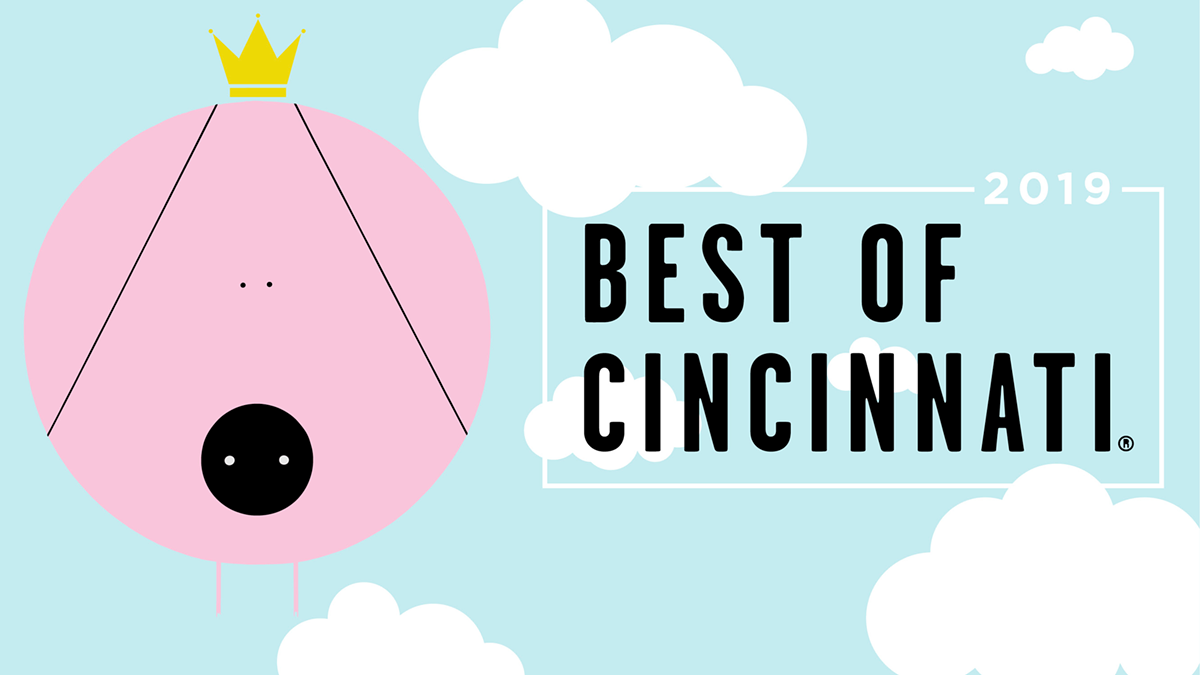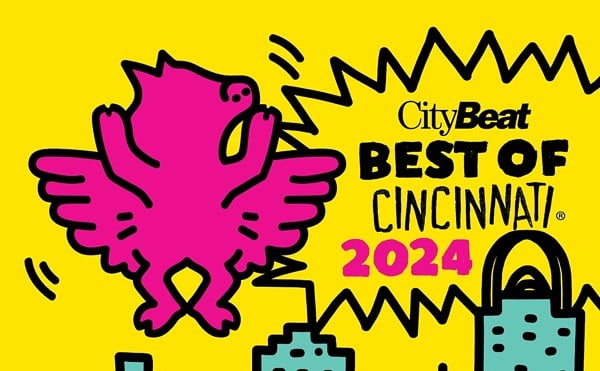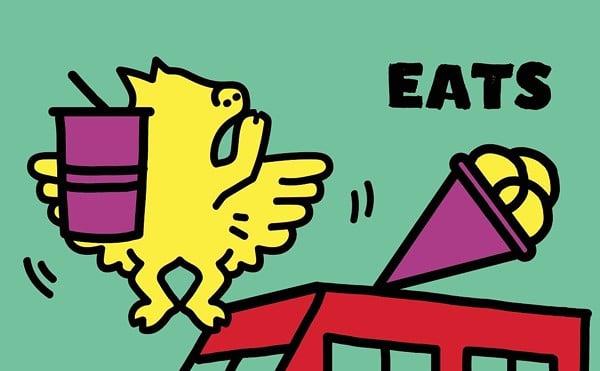Architect Terry Brown was a University of Cincinnati professor of architecture and interior design, but to most in our region he’s known as the guy behind Hyde Park’s famed “Mushroom House.” Guests at street level will notice a winding entry staircase and misshapen exterior constructed of metal, glass, ceramic and warped wood shingles, suggesting a fairy tale or bizarre, otherworld-esque appearance that looks like a very large mushroom. The one-bedroom, one-bath 1,260-square-foot structure was built by Brown and his students from 1992 to 2006, and served as a second residence for Brown until his death in 2008. Mushroom House, 3331 Erie Ave., Hyde Park.
This year, Cincinnati transit activists the Better Bus Coalition took it up a notch, providing free bus benches, pushing successfully for the city’s first bus-only lane during downtown rush hour and introducing a ballot initiative to boost bus funding. The coalition has done tons of social media activism around Metro’s struggles, highlighting aging buses, riders left waiting in the cold and more in daily posts. But the group takes things several steps further, too. They’ve engaged residents to create their own roadmap to a better Metro, for example. It remains to be seen whether voters will approve their proposed Cincinnati payroll tax increase, which the group estimates would cost a person in Cincinnati making $40,000 a year an extra $6.67 a month. Either way, expect the Better Bus Coalition to stay active in pushing for better transit service. Better Bus Coalition, betterbuscoalition.org.
The renovated Ziegler Park Pool is turning into not only a community hot spot, but also a hip place to see and be seen. Partly because of the location (across from Alumni Lofts in the former School for Creative and Performing Arts), partly because of the cost (daily admission is $4 for adults, with a sliding fee scale for season passes) and partly because of the features. Helmed by 3CDC, this former Cincinnati Recreation Commission pool has undergone a significant makeover to encompass three distinct sections: a zero-depth wheelchair-accessible area, an area with lap lanes and another with a diving board and rock-climbing wall. As a community-first pool, the urban swim club also offers lessons, a swim team and activities like water aerobics. But we’re here for the Adult Swim parties. During these 21-and-up nights held monthly during the summer last year, there were DJs, wine, local craft beers (and Bud Light) and food trucks. In addition, Ziegler also hosted a Dog Swim to close out the season, inviting vaccinated and well-behaved canines into the pool for a dip. Ziegler Park Pool, 1322 Sycamore St., Over-the-Rhine, zieglerpark.org.
2. American Can Lofts
3. The Boulevard at Oakley Station
4. Aqua on the Levee
5. Harper’s Point Apartments
6. Alumni Lofts
7. Newberry Lofts on 6th
8. Woodbrooke Apartments
9. The Waldo Apartments
10. The Gramercy on Garfield
2. Over-the-Rhine Community Housing
3. Model Group
2. Union Terminal
3. Cincinnati Observatory
2. Northside
3. Clifton
Like a mini version of the iconic London Eye, Skystar is a 15-story “observation wheel” that went up at The Banks downtown at the end of August to celebrate the riverfront development’s 10th anniversary. The Ferris wheel features 36 glass-enclosed, climate-controlled gondolas that take up to six riders on a 12-minute spin for a unique view of the river and Cincinnati and Northern Kentucky skylines. The portable — yes, portable — tourist attraction has been traveling across America, setting up shop in cities including Norfolk, Virginia and Louisville, Kentucky to offer elevated views and a novel pop-up experience. At night, the wheel turns into a glowing orb with more than 1 million colored LED lights and casts a pretty cool neon reflection into the waters of the Ohio River. Skystar became so popular that the company extended its original stay from August to December 2018 through mid-June 2019, which means it will be around for Opening Day, the Taste of Cincinnati and Asian Food Fest. More than 100,000 people have ridden the wheel since its arrival. Skystar, 55 E. Freedom Way, Downtown, skystarwheel.com.
2. Brian Garry
3. Pete Rose
4. Molly Wellmann
5. Tamaya Dennard
6. Bob Herzog
7. Anthony Muñoz
8. Nick Lachey
9. Drew Lachey
10. Cam Hardy (TIE)
10. Chris Seelbach (TIE)
2. Xavier University
3. Northern Kentucky University
2. John Boehner
3. Bill Cunningham
Monica Williams spent the last six years cooking soul food at her popular West End take-out spot Just Cookin’, often drawing lines of customers eager for her meatloaf, cornbread, ribs, greens, grilled salmon and other home-cooked favorites. Just one problem: Williams’ spot was in the historic State Theater on Central Avenue, which had to come down to make way for FC Cincinnati’s new MLS soccer stadium. The $250 million facility, helped along by $34 million in infrastructure spending from the City of Cincinnati and another $15-$22 million from Hamilton County for a parking garage, signals big changes likely for the historically predominantly black neighborhood with a median household income of just $15,000 a year. FCC and city officials have promised those changes will bring more investment, more jobs and more opportunity, but they also mean a big transition for the businesses that were once in the stadium’s footprint. Williams’ restaurant held its last day on a Friday in November 2018. The atmosphere was festive, but sad, too — the end of an era for the restaurant’s customers and for Williams, as well as for her mother, father, grandmother, nephew and niece, all of whom worked at Just Cookin’. That correlation between food, culture and family is one Williams subscribes to whole-heartedly. “Authentic soul food started in our grandparents’ homes,” she says. “It was the staple that held the family together. The glue. And we’re losing that. We’re losing our way of cooking in our community.” The move left Williams doggedly lobbying City Hall for help and hustling to find ways to keep her business afloat by catering events and cooking from pop-up locations. FC Cincinnati has pledged to continue working with her to get Just Cookin’ back up and running. What is next for Williams is still unclear, but if her grit and tenacity are any indication, you can bet she’ll still be cooking.
2. Matthew 25: Ministries
3. The Friends of the Public Library of Cincinnati and Hamilton County
Greater Cincinnati has a reputation as an affordable city, at least compared to the soaring, four-figure average rents in places like New York City and San Francisco. But that’s deceptive. Hamilton County has a 40,000-unit gap in affordable housing, according to a study by the Greater Cincinnati Local Initiatives Support Corporation — a huge deficit that Over-the-Rhine Community Housing is working full-time to address. OTRCH has served its namesake neighborhood for more than four decades by working to ensure affordable housing for low-income residents and has grown to provide more than 470 units of such housing in Cincinnati. And the past year has been a big one: OTRCH has won grants and launched projects with a range of partners to bring new affordable units online. That hard work hasn’t gone unnoticed. Executive Director Mary Burke Rivers, who has led OTRCH for 25 years, was named one of 2018’s Women of the Year by the Greater Cincinnati Foundation and The Cincinnati Enquirer. Over-the-Rhine Community Housing, 114 W. 14th St., Over-the-Rhine, otrch.org.
What is it with Cincinnati and gorillas? This year, the Cincinnati Zoo fought a pitched legal battle to regain custody of Ndume, a 37-year-old gorilla the zoo loaned to the California-based Gorilla Foundation in 1991. Ndume was supposed to be a boo for Koko, the famous gorilla sign-language prodigy trained by Gorilla Foundation co-founder Penny Patterson. But Koko swiped left, so to speak, and she and Ndume never hit it off. Dating is hard. Koko passed away last year, triggering a clause in a 2015 agreement between the foundation and the zoo for Ndume’s return to Cincinnati. Ndume is the last gorilla at the Gorilla Foundation, and the Cincinnati Zoo and other groups, including People for the Ethical Treatment of Animals (PETA), have suggested he has been isolated and could receive better care and opportunities to engage with other gorillas at a larger facility. In legal filings, the Cincinnati Zoo called his return “urgent.” The only problem? The Gorilla Foundation didn’t want to let Ndume go, saying the trip back to Cincinnati could kill him. (We all have that high school friend who went to college in the Golden State and now feels the same way, right?) But after a lawsuit, a federal judge ordered Ndume’s return to the Queen City. Cincinnati Zoo & Botanical Garden, 3400 Vine St., Avondale, cincinnatizoo.org.
2. The Friends of the Public Library of Cincinnati and Hamilton County
3. Cincinnati Nature Center
Yep, the rumors are true: The Capitoline Wolf statue in Eden Park was a gift from Italian dictator Benito Mussolini — and that’s not even the strangest part. The bronze sculpture depicts a she-wolf nursing two young boys, and it’s every bit as intriguing to witness in person as you would imagine. Intended to honor Lucius Quinctius Cincinnatus, Roman statesman, farmer and namesake of our dear city, the two thirsty boys represent Romulus and Remus, twins whose story relates to the founding of Rome — in fact, various images of the boys suckling a she-wolf have served as symbols of the Roman people since ancient times. So how did it get here? Mussolini sent it over for a Sons of Italy convention in 1929… sort of: He gave us an exact replica of one in Rome’s Musei Capitolini, but it was switched out for a larger one in 1931. And that is the one that has remained in place ever since. Inscribed with “Il Governatore di Roma alla Citta di Cincinnati 1931 Anno X” — “from the governor of Rome to the city of Cincinnati in 1931 (year 10 of Mussolini’s reign)” — it sits at Twin Lakes, a former quarry that now boasts two lakes and views of the Ohio River. Eden Park, 950 Eden Park Drive, Mount Adams, cincinnatiparks.com.
Cincinnati saw two iconic landmarks — The Manse Hotel and the Mt. Airy Water Towers — protected this year with local historic landmark designations. Walnut Hills’ Manse Hotel, first constructed in 1876 as a single-family home, became a vital stopover for black visitors to Cincinnati when a black businessman named Horace Sudduth purchased it in 1931. At the time, accommodations in the city were still segregated, and black residents of Cincinnati had few places where they could celebrate weddings, hold meetings of social and professional groups or put up distinguished out-of-town guests. It’s hard to overstate the cultural significance Sudduth’s new hotel would come to have for Cincinnati’s black community. The Manse was the site of Ezzard Charles’ post-match press conference after his victory over Joe Louis to claim boxing’s world heavyweight title. Cincinnati Reds first baseman Frank Robinson lived in the Manse in 1956, the year he won Major League Baseball’s Rookie of the Year award. James Brown stayed multiple times in the mid-1950s when he came to Cincinnati to record for King Records, and for a time considered it his second home. Some historians believe Hank Ballard wrote “The Twist” in the hotel before recording his version at King. Now, all that history is protected and the building could soon become affordable housing for seniors. Another Cincinnati landmark also got protection this year: Mt. Airy’s iconic water towers. The 90-year-old structures are a big deal for a few reasons. First, the seven six-story tanks and six seven-story towers (one of which houses a staircase) sit 962 feet above sea level on the highest point in Cincinnati. When they were built in 1927, they represented the first municipal water source for a number of West Side Cincinnati communities, including Cheviot, College Hill, Mt. Airy, North Fairmount, Price Hill and other nearby neighborhoods, which had previously gotten water from cisterns. The reliable water supply helped spur development of those areas. Then-Water Works Commissioner J.A. Hiller designed the structure. The towers are said to be a nod to another historic Cincinnati landmark — the Elsinore Arch that welcomes visitors to Eden Park, which was completed in 1883. That arch, built as part of the reservoir that used to occupy the park, was the first project by the city’s Water Works to use the distinctive castle-like architecture. The Mt. Airy Towers were the last. The towers are iconic enough that they’ve become the symbol used by the neighborhood’s community council and other civic bodies to represent Mt. Airy. Last year, it seemed like the water towers could face partial demolition. But Greater Cincinnati Water Works announced they have a plan to keep the towers intact and Cincinnati City Council has given them historic protections.
2. Fischer Homes
3. Drees Homes







